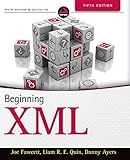Best XML Parsing Tools to Buy in December 2025
To check all the values of a specific field in an XML using Groovy, you can use the XmlSlurper class provided by Groovy. You can parse the XML and then iterate through all the elements to retrieve the values of the specific field you are interested in. You can use the find() method to find all elements with a specific name and then access the values of those elements. You can also use XPath expressions to navigate through the XML and retrieve the values of the specific field. By using these techniques, you can easily check all the values of a specific field in an XML using Groovy.
What is the difference between XmlParser and XmlSlurper in groovy?
XmlParser is a class provided by Groovy for parsing XML documents and extracting information from them. It is a low-level parser that allows you to navigate through the XML structure using methods like depthFirst(), breadthFirst(), and find(). XmlParser provides more control over the parsing process, but requires more code to handle different situations.
XmlSlurper, on the other hand, is a high-level parser that simplifies XML parsing and navigation in Groovy. It treats the XML document as a groovy.util.slurpersupport.NodeChild object, which provides a more convenient way to access and manipulate the XML structure. XmlSlurper allows you to use Groovy's GPath syntax to query and manipulate XML data easily.
In summary, XmlParser provides more control and flexibility in parsing XML documents, while XmlSlurper provides a more convenient and easier way to work with XML data using Groovy's GPath syntax.
How to check all the values of a specific field in an xml using groovy for beginners?
To check all the values of a specific field in an XML using Groovy, you can use the XmlSlurper class that is available in Groovy. Here's a step-by-step guide for beginners:
- First, you need to create an instance of XmlSlurper and parse the XML content. You can do this by using the following code snippet:
def xml = """ value1 value2 value3 """
def slurper = new XmlSlurper().parseText(xml)
- Next, you can iterate over the specific field (in this case, the "item" field) and print out all the values. You can do this using the following code snippet:
slurper.item.each { item -> println item.text() }
This will print out all the values of the "item" field in the XML document.
- You can modify the field name and XML content according to your specific requirements.
By following these steps, you can easily check all the values of a specific field in an XML using Groovy. Happy coding!
How to sort xml nodes based on a specific field in groovy?
In Groovy, you can use the XmlSlurper class to parse and manipulate XML data. To sort XML nodes based on a specific field, you can use the XmlSlurper's sort() method along with a custom Comparator.
Here's an example code snippet that demonstrates how to sort XML nodes based on a specific field:
def xmlData = ''' John 30 Alice 25 Bob 35 '''
def xml = new XmlSlurper().parseText(xmlData)
def sortedXml = xml.item.sort { a, b -> Integer.parseInt(a.age.text()) <=> Integer.parseInt(b.age.text()) }
println XmlUtil.serialize(new XmlBuilder(sortedXml).root)
In this example, we first parse the XML data using XmlSlurper. Then, we use the sort() method on the 'item' nodes and provide a custom Comparator that compares the 'age' field of each 'item' node as integers. Finally, we serialize the sorted XML data to print the sorted nodes.
You can adjust the Comparator logic based on your specific sorting requirements.
What is the best practice for caching xml data in groovy scripts?
One best practice for caching XML data in Groovy scripts is to use the built-in caching mechanisms provided by Groovy and its associated libraries. Some possible options include:
- Use the @Memoized annotation provided by Groovy to cache the results of a method call. This annotation can be applied to a method that parses and processes the XML data, ensuring that the data is only fetched and processed once and then cached for subsequent calls.
- Utilize libraries such as Ehcache or Guava Cache to create and manage a cache for the XML data. These libraries provide more advanced caching features such as expiry times, size limits, and thread safety.
- Store the parsed XML data in a global variable or class-level property within your Groovy script. This way, the data is accessible and reusable throughout the script without the need to re-parse the XML each time.
- Consider using a specific caching library designed for XML data, such as Apache JCS or XMLCache. These libraries are tailored for caching XML data and offer additional features and optimizations specifically for XML.
By implementing one of these caching practices, you can optimize the performance of your Groovy script and reduce the overhead of repeatedly fetching and processing XML data.
What is the significance of XMLSlurper in groovy programming?
XMLSlurper is a class in Groovy that allows for easy manipulation and parsing of XML documents. It provides a simple and intuitive way to access and modify elements and attributes within an XML document using Groovy's powerful syntax.
The significance of XMLSlurper in Groovy programming lies in its ability to simplify the process of working with XML data. It allows developers to write concise and expressive code for tasks such as extracting data, modifying elements, and generating XML output. This can help improve productivity and reduce development time when working with XML-based applications.
Overall, XMLSlurper is a valuable tool for handling XML data in Groovy applications, making it easier for developers to work with XML documents without having to deal with complex APIs or libraries.



